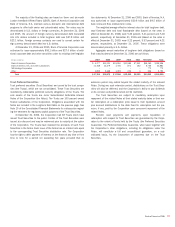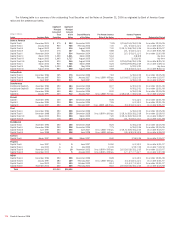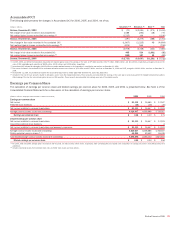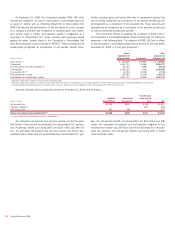Bank of America 2006 Annual Report Download - page 130
Download and view the complete annual report
Please find page 130 of the 2006 Bank of America annual report below. You can navigate through the pages in the report by either clicking on the pages listed below, or by using the keyword search tool below to find specific information within the annual report.The Corporation also sells products that guarantee the return of prin-
cipal to investors at a preset future date. These guarantees cover a broad
range of underlying asset classes and are designed to cover the shortfall
between the market value of the underlying portfolio and the principal
amount on the preset future date. To manage its exposure, the Corpo-
ration requires that these guarantees be backed by structural and invest-
ment constraints and certain pre-defined triggers that would require the
underlying assets or portfolio to be liquidated and invested in zero-coupon
bonds that mature at the preset future date. The Corporation is required to
fund any shortfall at the preset future date between the proceeds of the
liquidated assets and the purchase price of the zero-coupon bonds. These
guarantees are booked as derivatives and marked to market in the trading
portfolio. At December 31, 2006 and 2005, the notional amount of these
guarantees totaled $4.0 billion and $6.5 billion. These guarantees have
various maturities ranging from 2007 to 2013. At December 31, 2006
and 2005, the Corporation had not made a payment under these prod-
ucts, and management believes that the probability of payments under
these guarantees is remote.
The Corporation also has written put options on highly rated fixed
income securities. Its obligation under these agreements is to buy back
the assets at predetermined contractual yields in the event of a severe
market disruption in the short-term funding market. These agreements
have various maturities ranging from two to five years, and the
pre-determined yields are based on the quality of the assets and the struc-
tural elements pertaining to the market disruption. The notional amount of
these put options was $2.1 billion and $803 million at December 31,
2006 and 2005. Due to the high quality of the assets and various struc-
tural protections, management believes that the probability of incurring a
loss under these agreements is remote.
In the ordinary course of business, the Corporation enters into vari-
ous agreements that contain indemnifications, such as tax
indemnifications, whereupon payment may become due if certain external
events occur, such as a change in tax law. These agreements typically
contain an early termination clause that permits the Corporation to exit the
agreement upon these events. The maximum potential future payment
under indemnification agreements is difficult to assess for several rea-
sons, including the inability to predict future changes in tax and other
laws, the difficulty in determining how such laws would apply to parties in
contracts, the absence of exposure limits contained in standard contract
language and the timing of the early termination clause. Historically, any
payments made under these guarantees have been de minimis. Manage-
ment has assessed the probability of making such payments in the future
as remote.
The Corporation has entered into additional guarantee agreements,
including lease end obligation agreements, partial credit guarantees on
certain leases, real estate joint venture guarantees, sold risk participation
swaps and sold put options that require gross settlement. The maximum
potential future payment under these agreements was approximately $2.0
billion and $1.8 billion at December 31, 2006 and 2005. The estimated
maturity dates of these obligations are between 2007 and 2033. The
Corporation has made no material payments under these guarantees.
The Corporation provides credit and debit card processing services to
various merchants, processing credit and debit card transactions on their
behalf. In connection with these services, a liability may arise in the event
of a billing dispute between the merchant and a cardholder that is ulti-
mately resolved in the cardholder’s favor and the merchant defaults upon
its obligation to reimburse the cardholder. A cardholder, through its issuing
bank, generally has until the later of up to four months after the date a
transaction is processed or the delivery of the product or service to pres-
ent a chargeback to the Corporation as the merchant processor. If the
Corporation is unable to collect this amount from the merchant, it bears
the loss for the amount paid to the cardholder. In 2006 and 2005, the
Corporation processed $377.8 billion and $352.9 billion of transactions
and recorded losses as a result of these chargebacks of $20 million and
$13 million.
At December 31, 2006 and 2005, the Corporation held as collateral
approximately $32 million and $248 million of merchant escrow deposits
which the Corporation has the right to offset against amounts due from
the individual merchants. The Corporation also has the right to offset any
payments with cash flows otherwise due to the merchant. Accordingly, the
Corporation believes that the maximum potential exposure is not repre-
sentative of the actual potential loss exposure. The Corporation believes
the maximum potential exposure for chargebacks would not exceed the
total amount of merchant transactions processed through Visa and
MasterCard for the last four months, which represents the claim period for
the cardholder, plus any outstanding delayed-delivery transactions. As of
December 31, 2006 and 2005, the maximum potential exposure totaled
approximately $114.5 billion and $118.2 billion.
Within the Corporation’s brokerage business, the Corporation has
contracted with a third party to provide clearing services that include
underwriting margin loans to the Corporation’s clients. This contract stip-
ulates that the Corporation will indemnify the third party for any margin
loan losses that occur in their issuing margin to the Corporation’s clients.
The maximum potential future payment under this indemnification was
$938 million and $1.1 billion at December 31, 2006 and 2005. Histor-
ically, any payments made under this indemnification have been immate-
rial. As these margin loans are highly collateralized by the securities held
by the brokerage clients, the Corporation has assessed the probability of
making such payments in the future as remote. This indemnification would
end with the termination of the clearing contract.
For additional information on recourse obligations related to resi-
dential mortgage loans sold and other guarantees related to securitiza-
tions, see Note 9 of the Consolidated Financial Statements.
Litigation and Regulatory Matters
In the ordinary course of business, the Corporation and its subsidiaries
are routinely defendants in or parties to many pending and threatened
legal actions and proceedings, including actions brought on behalf of vari-
ous classes of claimants. Certain of these actions and proceedings are
based on alleged violations of consumer protection, securities, environ-
mental, banking, employment and other laws. In certain of these actions
and proceedings, claims for substantial monetary damages are asserted
against the Corporation and its subsidiaries.
In the ordinary course of business, the Corporation and its sub-
sidiaries are also subject to regulatory examinations, information gathering
requests, inquiries and investigations. Certain subsidiaries of the Corpo-
ration are registered broker/dealers or investment advisors and are sub-
ject to regulation by the SEC, the National Association of Securities
Dealers, the New York Stock Exchange and state securities regulators. In
connection with formal and informal inquiries by those agencies, such
subsidiaries receive numerous requests, subpoenas and orders for docu-
ments, testimony and information in connection with various aspects of
their regulated activities.
In view of the inherent difficulty of predicting the outcome of such liti-
gation and regulatory matters, particularly where the claimants seek very
large or indeterminate damages or where the matters present novel legal
theories or involve a large number of parties, the Corporation cannot state
with confidence what the eventual outcome of the pending matters will be,
128
Bank of America 2006
























